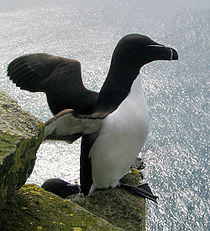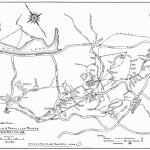There exists in Gatineau Park a lovely picnic site called Penguin. This is an unusual name for a geographic feature, lying as it does about eleven thousand kilometers from the nearest penguin habitat; therein lies a tale.
In winter skiers can park at P5, also called Penguin and if they head north they pass the sign for the Penguin Picnic Area and may head up Trail #1 toward Wattsford lookout. I’ve heard this steep pitch up toward Wattsford called the Penguin hill but in days of old it was known as Excelsior hill; excelsior is Latin for “higher.”
It appears from time spent squinting at the old maps that the present course of the Gatineau Parkway as it curves north after passing beneath the Kingsmere Road, follows quite closely the route of something called the Penguin Trail. This is another story from the annals of the Ottawa Ski Club. As an aside, what is now called the Penguin Picnic Area seems once to have been called the Meadow Picnic Field.
Skiers in the 1920s were looking for alternatives in trying to get in to Camp Fortune. There were no ski tows at the time. These were all cross country skiers. Camp Fortune at the time was a Lodge, not an alpine ski centre, though there were ski jumping enthusiasts who cross country skied into Camp Fortune for the jumping that took place there.
At the time there was a farm on the Kingsmere Road about the place where its bridge crosses the Parkway today. This was Young’s Farm and it was as far as the newly deployed municipal snow plow went. Consequently skiers taking the bus or those lucky few who owned cars and were daring enough to drive them (most of which were up on blocks for the winter) kept trying to bushwhack across the farm fences and wooded ravines between Young’s Farm and the bush road that ran up Excelsior hill. In to fill this evident need stepped Joe Morin the Ottawa Ski Club’s Director of Trails.
The Penguin Trail was short, spanning considerably less than a kilometer, but it was memorable. This is because Joe Morin claimed to have found a penguin in the snow just as they were finishing the trail. He caught it, put it in his backpack and skied it in to Camp Fortune where he and his Night Riders nursed it back to health. They made a sort of mascot of it and claimed that it must have walked from the southern hemisphere and that’s why it was so tired. Other people were skeptical and arranged for a visit by—as the 1943 Ottawa Ski Club Guide puts it—“learned and bespectacled ornithologists” to disprove the unlikely claim. The bird however, having regained its strength, flew out the window before the bespectacled doubters could inspect it and Joe maintained his claim that it had indeed been a penguin.
Modern day Park users may be aware that a penguin is a flightless bird. This undercuts Joe’s authority in the event of the bird leaving on the wing, though it may give a small degree of support to the “walking-thus-tired” theory.
Yet another theory has to do with a linguistic misunderstanding. Whereas English penguins do not fly, in French a pingouin is a bird that flies; it changes its name to razor billed auk in English and inhabits the north east Canadian coast, sometimes getting lost and finding its way quite far inland—though perhaps not walking.
Here’s an extract from that 1943 Ottawa Ski Club Guide:
The village of Old Chelsea, nestling at the foot of the Gatineau Hills, was for a long time the terminus of the wheeled vehicles after t eh latter made their appearance on the Gatineau Roads in winter—the end of the ruts, so to speak. There were sleigh ruts further on of course, but these were insignificant scratches in comparison to the deep, cave like tracks left by buses and motor cars. When the municipal snow plough, equipped with a new engine, managed to crawl up to Kingsmere, busses and cars followed in its wake, cautiously at first, going no farther than Young’s place, and not even that far when the going was bad. It was not a very great gain, except perhaps for the bus company which charged fifteen cents more for this extra short mile; in fact it was no gain at all for the skiers who had almost the same distance to cover to get to the foot of Excelsior hill, there to pick up the Canyon trail, than if they had started from Old Chelsea, but they could not be convinced of that and they called on the Ottawa Ski Club to open a way through the maze of wire fences and ravines that stood between them and their objective. This new trail was cut in short order by the Company of the Night Riders and was named the Penguin.
And Thereby hangs a tale: Late in the afternoon of a cold, winter day, just as the sun was sinking in a sea of gold and red behind King’s mountain, a gang of Night Riders led by their Captain Joe Morin, was busy putting the finishing touches on the new trail and snipping the last barbed wire when they heard a noise like the flapping of wings in a deep ravine near by. Joe went over to investigate and found a rather large, strange looking bird floundering helplessly in the snow. He picked it up tenderly, put it in his haversack, and brought it to the dormitory of the old Camp Fortune Lodge where the bird quickly revived under the influence of warmth and good food. It was at once identified as a penguin by C. E Mortureaux who had seen a few penguins in zoos, many pictures of them in books and had read a log about their habits. The bird stood up exactly like a penguin, making a neat little bow whenever any one entered the dormitory, uttering an incessant prattle that no one could understand, not even the Night Riders, accustomed though they were to the meaning of strange sounds in the bush. All these were clear cut characteristics of the Penguin family, the standing up habit, like a man, the affability and civility and the inarticulate, unintelligible language. The bird was a penguin, there could not be a doubt of that, and he was accepted and adopted as such b the Company of the Night Riders with whom it made fast friends.
Not so by the world at large, however. The news that a penguin had been found in the wilderness of the Gatineau hills met with general skepticism, and a violent controversy raged for a while. Penguins live in the Antarctic circle said doubting Thomases; they cannot fly, they only walk, and rather slowly at that. How could one of the tribe possibly tramp all the way from the Polar regions to Camp Fortune? The thing was preposterous. To that, the supporters of the Penguin theory replied that this particular bird might have been a champion walker. Anyway, the condition of extreme weakness in which it was found clearly showed that it had come a very long way. Possibly it was brought on the wings of a storm. Stranger things than that have happened. Perhaps also penguins had been creeping closer to us with the new ice age that was coming [clearly this was written before worries of climate change and global warming were dreamt of]. Anyhow, if it was not a penguin, it was up to the other chaps to prove it.
The other chaps took up the challenge. They refused to be taken in by this impersonator, as they called it, who posed as a penguin. They filled up a sleigh load with learned and be-spectacled ornithologists, and another one with all available treatises on birds, including the works of Audubon, and the little caravan set out for Camp Fortune on a bright winter day. Whether the feathered visitor had wind of their coming and did not want its identity revealed, whether it just happened that it did not want to trespass any longer on the hospitality of Camp Fortune, no one ever knew, but just as the steps of the winding stairway leading to the dormitory were groaning under the weight of the ponderous scientists, the bird jumped on the sill of an open window, flew high into the sky with powerful strokes of its short wings, soared for a while, orienting itself, and then flew straight towards the great northland. It never came back. Now how did that penguin ever learn to fly?
A very plausible theory was offered that appeared to solve the mystery and left both camps satisfied. The bird was not an English penguin but a French “pingouin”, in fact a member of the auk family – not the great auk which has become completely extinct through the greed and thoughtlessness of man – but the “razor billed auk” (Alca torda) a close relative of the penguin, known under the name of “Pingouin commun” by the French. The razor billed auk inhabits the coasts of the North Atlantic. Specimens at times have been found far inland, in a starving condition, unable to return to their sea homes. Their wings are short but powerful, and they can fly a long distance. And this is how the short bit of trail from Young’s farm to Excelsior, over the brow of the Bald hill, came to be known as the “Penguin’s”. After all, does not this sound better than the “Razor billed auk’s trail”?
To this day, however, Captain Joe Morin who, eighteen years ago, on a cold winter night, found this strange bird in a deep ravine on Lemay’s farm, has remained convineced that it was a real “penguin”. And he might be right. Chi lo sa ! [which I believe is an Italian phrase meaning “who knows?]
 This photo of a razor billed auk shows why there might have been some confusion those nearly 90 years ago.
This photo of a razor billed auk shows why there might have been some confusion those nearly 90 years ago.
By the merest coincidence in the fall of 2009 I happened to interview the Philip Durkin, Principal Etymologist for The Oxford English Dictionary and he happened to mention one of the most recent theories on the etymology of the name of this bird, a penguin. In part he said that it may have been the extinct Great Auk that was first called a penguin by Welsh sailors in the 1500s and that this name only later was applied to penguins of the Antarctic. The Welsh name may have come from one of the North Atlantic islands off Canada that had been inhabited by these birds which could have been called “white head” because of its white cliffs (perhaps white with guano?) the phrase in Welsh being rendered as pen gwyn. The auk then taking its penguin name temporarily from the name of the island it was found on in such numbers.
According to Wikipedia the Great Auk was brought to extinction based on being hunted primarily for its downy feathers, and this despite legislation to protect it as early as 1794 in London. The Wikipedia article even identifies the names of the people who killed the last Great Auk in the middle 1800s.
Credits: I want to thank the Canadian Ski Museum for allowing me to use a couple of the images from the Ottawa Ski Club. Please give the museum your support.
The images of penguins are from the Wikipedia commons and are listed there as either in the public domain, or usable with credit. The following links are credits to those images requiring attribution:
- http://commons.wikimedia.org/wiki/File:Pygoscelis_antarctica_trying_to_get_to_iceberg.wmv.OGG
- http://commons.wikimedia.org/wiki/File:Eudyptes_chrysocome.JPG
- http://commons.wikimedia.org/wiki/File:Penguin,_Strait_of_Magellan.jpg
- http://commons.wikimedia.org/wiki/File:Penguin_in_Captivity.JPG
- http://commons.wikimedia.org/wiki/File:Emperor_Penguin_Manchot_empereur.jpg
- http://commons.wikimedia.org/wiki/File:Eudyptes_chrysocome.jpg
- http://commons.wikimedia.org/wiki/File:Galapagos_penguin_(Spheniscus_mendiculus)_-Isabela2.jpg
- http://commons.wikimedia.org/wiki/File:Adelie_Penguin.jpg
- http://commons.wikimedia.org/wiki/File:Pygoscelis_papua.jpg
- http://commons.wikimedia.org/wiki/File:Penguins_Edinburgh_Zoo_2004_SMC.jpg


